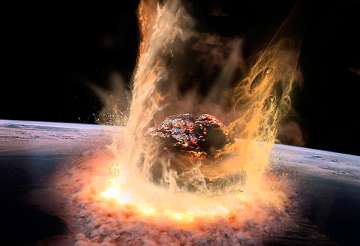Madrid, May 20: Astronomers at the LaSagra Observatory in Spain have disclosed that a newly discovered 150-foot-wide asteroid may come so close to the Earth in February that it might hit satellites, Daily Mail reported.
The asteroid named 2012 DA14 can come close enough to Earth to potentially disrupt geosynchronous satellites on February 15, 2013.
However, NASA says the chance of the asteroid hitting Earth is 0.031 percent.
But if it did, it would hit with the force of a 2.4 megaton explosion, similar to the mysterious Tunguska event of 1908 which leveled hundreds of square miles of Siberian forest.
The path of 2012 DA14 as projected through February 15, 2013 shows the asteroid falling inside the orbit of geosynchronous satellites
It is not expected that the path of 2012 DA14 will come anywhere near to hitting Earth in 2013, but scientists have added it to the list of near-Earth objects to examine for its flypast in 2020
At the moment, the exact orbital path of the asteroid is being determined by NASA and astronomers are erring on the side of caution in case it does come in contact with a satellite.
'That's very unlikely, but we can't rule it out,' said Paul Chodas, a planetary astronomer at NASA's Jet Propulsion Laboratory (JPL) in Pasadena California.
While the the asteroid is currently a 'fuzzy little blob', as seen through telescopes, 2012 DA14 may eventually come to pass 21,000 miles away from the Earth putting synchronous satellites in the firing line.
'The orbit for 2012 DA14 is currently very Earth-like, which means it will be very close to Earth on a regular basis,' said Chodas.
2012 DA14 will pass so close that astronomers will be able to observe it with a telescope, but even though satellites might be in danger, the International Space Station is not.
In the preceding months to February, NASA will try to form a fuller picture of where and how close the satellite will get.
'We don't know exactly where it is, and that uncertainty maps through to an uncertainty in the orbit and predictions,' said Steven Chesley, who also works at JPL.
But for now, no one at NASA is worried that the asteroid will hit but say that 2012 DA14 might be visible from Earth as it flies past.
'It might be visible to people with good binoculars or a small telescope,' said Chodas.
Even if 2012 DA14 did hit Earth it would not cause any long term damage to civilization but would cause massive loss of life if it hit a populated centre
'For such a small object, that's really unusual.'
While astronomers examine their initial estimate of a 0.031 percent chance of 2012 DA14 hitting earth, they cannot rule out the possibility of it hitting in 2020 on its next fly-pass.
That is because they will have to see how close 2012 DA14 gets to Earth in February and how much our gravitational pull affects its course for its next fly by in 2020.
If it does hit, scientist believe that its south-bound approach mean that it will hit Antarctica or the Southern Ocean.
In 1908 an unkown object from space caused hundreds of square miles of forest to flatten in Tunguska in Siberia and it is thought that similar damage would be wreaked by 2012 DA14 if it did hit in 2020
The detonation of the 140,000 ton rock would not end civilization but would potentially cause massive loss of life if it hit a populated centre.
In 1908 it is believed that a comet of an asteroid exploded in the skies above Tunguska in Siberia, causing trees for hundreds of square miles to flatten horizontally.
Regardless of any future dangers, NASA agree that it is good to locate these potential dangers, so that we can add 2012 DA14 to the list of near-Earth asteroids.
'We're now on top of it,' said Chelsey.
Latest World News
